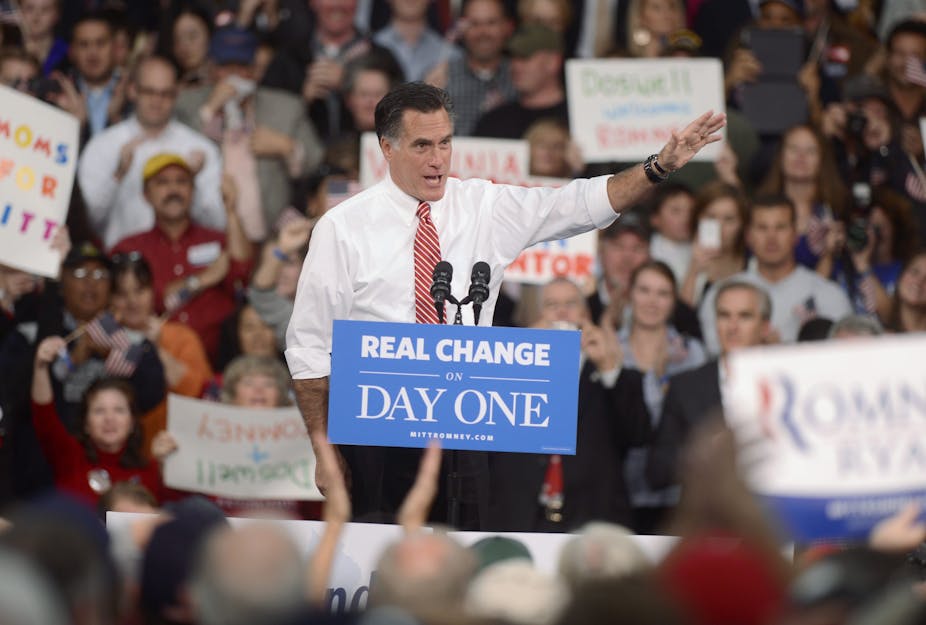In these last days of the United States presidential election, the images from the campaign trail document the confusion of the Mitt Romney-Paul Ryan campaign. The unclear Republican message is no match for the slick, seasoned Barack Obama marketing machine.
The Republican bluff
Republican supporters claim the Romney-Ryan ticket is in a strong position. The campaign has made some seemingly assertive moves. Pro-Republican interest groups have spent heavily on advertising the Democrat-leaning states of Michigan ($US14.5 million), Pennsylvania ($US13.3 million), and Wisconsin ($US5 million and counting). Campaign aides have cited this advertising spend as evidence of their confidence.
Recent campaign stops have been called “Victory Rallies”, some five days prior to the start of voting. A few days ago Romney appeared behind the presumptuously written placard “Real Change On Day One”, referring to his assumed future term as President.
A flip and a flop
None of this changes the fundamentally reactive and consequently confused nature of the 2012 Republican presidential campaign. The “Victory Rally” title is being used in conjunction with the title “Real Recovery Road Rally”. It was also used, apparently by accident, during the poorly executed Republican storm relief event.
The Romney-Ryan message has been ever-changing and frequently contradictory to their own former position. This gives the candidates a big problem. Staying “on message” means retracting former statements, denying long-held beliefs and generally looking dishonest. This is most obvious in the part of their campaign that seems to have been the least considered: its visual image.
The notable Republican campaign placards are a case in point. Romney’s lectern placards when speaking in Ohio months ago displayed the message “Middle Class Tax Relief”. More recently his Ohio lecterns have changed to, among other things, “Farmers For Mitt”. While there are certainly some farmers who could be considered middle class, the shift in their target audience is clear: from urbanites with double incomes and investment properties to Mr and Mrs Rural America.

In a more blatant turnaround, in June in Washington, Romney stood behind a lectern placard that read “Repeal And Replace Obamacare”. A few months later he spoke in Florida behind a placard bearing the statement “Protect and Strengthen Medicare”. Such contradictions may have gone unnoticed before digital photography and the internet. As things stand, every photograph documenting these policy reversals by the Romney-Ryan campaign provides further evidence of what Obama has pithily named “Romnesia”.
Three memes to bind them
This highlights another front on which the Democrats’ campaign has been particularly successful, in part aided by Republican own goals: social media. The “Romnesia” and “Binders Full of Women” memes have been significant factors in the visual communication of this year’s election. Spoof videos, such as “Mitt Romney Style”, a witty swipe at Romney in the style of Korean pop sensation PSY’s Gangnam Style, have also achieved millions of views.
What have pro-Romney supporters come up with to rival these memes? A woeful collection of communist-referencing and sometimes racist images. Each of these attempts at satire commit the cardinal sin of aspiring memes: they are not funny. Funny videos on the Internet are unlikely to encourage people to vote. However, the effect of millions of Internet users laughing at a candidate looking like a fool should not be underestimated.

A lacklustre last stand
In the days before the polls open, the details of the final pro-Republican ads to be aired before and on election day are starting to emerge. The assortment of last-ditch efforts at winning over voters include appealing to African American voters in Ohio (“Because Lincoln Freed The Slaves”) as well as Cuban Americans in Florida (by equating Obama with Fidel Castro and Che Guevara).
Another panicked efforts at recruiting voters uses Donald Trump’s voiceover in pro-Romney-Ryan radio advertisements, despite his awkward past relationship with the campaign. These recently released ads are in keeping with the tone set by the controversial Romney-Ryan “Jeep To China” ad which started to air earlier this week. Although the messages are vastly different, the theme of playing on local fears and relying on untruths runs throughout each. As I read about and watch these advertisements, one question keeps recurring: how low will the Romney-Ryan campaign go?
The final countdown
As the polls predict a neck-and-neck race for the popular vote, and an Electoral College vote slightly in favour of the Obama-Biden ticket, the visual story shows a clear winner. While the Obama-Biden ticket remains typically on-message, the Romney-Ryan effort reads like a litany of campaign sins. It remains to be seen whether the worst is yet to come in Romney’s last stand.

